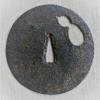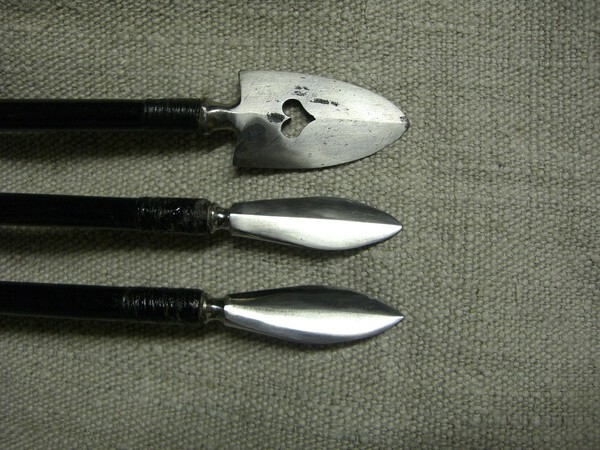-
Posts
5,947 -
Joined
-
Last visited
-
Days Won
19
Everything posted by ROKUJURO
-

Masamune tanto - translation of papers
ROKUJURO replied to Prepeleac's topic in Translation Assistance
Maybe it refuses to be loaded as it's a bad photo and standing on it's head.... -

'The Challenge' on youtube
ROKUJURO replied to Pete Klein's topic in General Nihonto Related Discussion
Perhaps because it's a really bad film, even if you consider the times it was made. -

They are forging everything these days.
ROKUJURO replied to nihonto1001's topic in Auctions and Online Sales or Sellers
...and the smaller version for WAKIZASHI is called Mini-Cooper..... . -

Sword construction in general vs. periods
ROKUJURO replied to CurtisR's topic in General Nihonto Related Discussion
I don't share this opinion. Japan had an advanced knowledge in their own and very narrow field of military technology, while the Europeans were not less skillful with their arms respectively. You will have to compare arms side by side and of the same period of time. -

YANONE from EDO period, ca 1750-1850
ROKUJURO replied to bmoore1322's topic in General Nihonto Related Discussion
This is a typical 'shoot-and-forget-about-it' arrowhead, a standard type. I have seen HAMON on YANONE with a flat design but technically it is almost impossible to produce a HAMON in a small and compact piece of steel like the arrowhead shown. -
To my old eyes, No. 1 is cast. Look at the corners of the SUKASHI. There seems to remain some residue from casting.
-
You cannot retemper a part of a blade. Trying this would always produce a non-tempered zone in the blade.
-
I don't believe this to be a YUMI YARI. There is no possibility to hook the loop in, and the long extension shows a hole, but nobody wants a screw or nail in his bow! I remember having seen a picture of a YUMI YARI which was quite small, so as not to reduce the performance of the bow. There is an old photo in my 'Japan department' showing my KYUDO teacher KAWASHIMA SENSEI in a fight demonstration with a 'palanquin arrow'. I am sorry not to know the technical term for it but it looked quite similar - a short but stout arrow, used for defense in limited spaces like palanquins. One could stabb with these arms but also throw them. Maybe the item is something of that kind.
-

My Japanese Sword New Polish Wakizashi Stout Naginata Naoshi
ROKUJURO replied to bmoore1322's topic in Nihonto
Brian, your last purchase is really a nice one, congratulations! I like the shape and the overall appearance. Do you know how swords are stored in Japan? Have a look in the books! There is a reason why they don't have 10 sword-racks except for wooden training weapons in a DOJO. Presentation is not a matter of quantity. I know you like you weapons, but concentrate on quality, display one KOSHIRAE at a time with a TSUNAGI and leave your blades in SHIRASAYA in the TANSU! -
If you proceed as given by the Japanese recommendations, there ist no danger. You clean the blade first, then apply A SMALL AMOUNT of oil and disperse it thoroughly on the surface, then remove all oil again prior to putting the blade back in the scabbard. Leaving oil on the surface (oil does not 'dry', but in most cases it will harden earlier or later, a polymerisation process) leads to dust sticking to the surface (which will cause scratches as you move the blade) and getting into the wood of the SAYA, thus preventing it to take up moisture. Preventing rust means keeping the blade dry.
-
Brian, as far as I know it is quenching, not drenching. Read, Brian, read books!
-
Never seen before. Could possibly have been made on demand for a lefty.
-
Yes, that ist the case with SHINKEN/GENDAITO.
-

Looking for origin of arrow feathers
ROKUJURO replied to Anthony de Vos's topic in General Nihonto Related Discussion
Wow, what a wonderful collection! Thank you for sharing, very much appreciated! I understand now that you don't need to buy NEW arrowheads. As you are knowledgeable in this field, I'd like to ask again if you happen to know who forged these YANONE. In medieval times, European smiths had a tendency to specialize on a narrow spectrum of their respective craft, so we had up to 46 different professions in the vast field of forging, and of course we had arrowsmiths. Was it the same in Japan? -
The same applies to me, but I will give it a try (arrow in the sky): Both are very skilfully made TSUBA (I don't want to go into details of the preservation). The details are very well designed and executed, and differ a lot from the many SOTEN copies on the market. Good original SOTEN TSUBA I have seen pictures of were finer in detail and displayed more SUKASHI. So if I said NARA, perhaps one of the more knowledgeable members here might tell us why it is not.....
-
Moisture is normal in humidity.
-
Congratulations! It is a very nice TANTO, and you can be proud of it! Without covering all aspects of preservation I only want to make a remark on oiling: never oil your blade and put it back into a SAYA as fine dust will stick to the blade resulting in scratches as you move the blade. Oil is sucked up by the wood of the SAYA preventing it to suck up humidity. As Japan is comparable in climate to Hawaii it might be best to follow the classical recommendations for sword care in that country.
-
'DAIMYO' Jean has already explained the criteria. Remains to add that in an altered NAGINATA you will not find a BOSHI (returning curve) as a lot of material of the tip has to be removed to create a blade of even width.
-

Looking for origin of arrow feathers
ROKUJURO replied to Anthony de Vos's topic in General Nihonto Related Discussion
A long while ago I was lucky enough to purchase feathers from a big Chinese eagle from a falconer. This was quite cheap at that time, maybe there were no other KYUDOKA or arrowsmiths around. Also, you could try at a zoo or even at a traditional archery shop (longbow). If it was for private display only, big turkey or goose feathers may do the job as well - better than no feathers at all......As far as I know, not all SAMURAI could afford eagle feathers. -

Looking for origin of arrow feathers
ROKUJURO replied to Anthony de Vos's topic in General Nihonto Related Discussion
Anthony, thank you - that's what I understood from your previous post (.....I use original war heads only.....). I can only admire the artists who made them, and I wonder wether there were specialized arrow-smiths or wether they were made as a by-product by other smiths. Do you happen to know? -
No, unfortunately I had to destroy the hilt in order to examine the NAKAGO. It was a long wooden hilt, I remember, at least twice the length of an appropriate TSUKA, and it was glued to the NAKAGO, secured with a kind of MEKUGI, and then wrapped with a relatively fine rattan in full length. A part of this wrapping was lost, the rest quite well in place but a bit loose. The shape of the hilt was typically wider at it's upper end approaching the blade. The hilt was kind of crude workmanship compared to Japanese work, so I did not care to preserve it. The find is about 30 years back - yesterday........
-
Chris, As you mention Burma in this case, I may tell the story about the purchase of a NAGINATA. I browsed a small antique shop in Germany and asked the shop owner for anything related to Japanese arms. When he said he had nothing of that kind, I asked for other Asian arms. 'I have got a blade that might interest you', he replied and took something long wrapped in textile out of a drawer. When he unpacked it, it looked absolutely like a NAGINATA to me. I said spontaneously: ' Oh, there is in fact something Japanese!' But he contradicted me and said it was a Burmese DHA. To make a long story short, it WAS in fact a NAGINATA in mediocre condition mounted as a DHA, unfortunately signed GIMEI. I did not try to convince the shop owner and bought it as DHA at a better price.
-
David, did you notice the price?
-

Looking for origin of arrow feathers
ROKUJURO replied to Anthony de Vos's topic in General Nihonto Related Discussion
Sorry, I cannot contribute to the 'feather' subject, but I know that it is difficult and expensive to buy KYUDO arrows with eagle feathers (even without closer specification) from your standard KYUDO shop in Japan. Nevertheless, a real specialist might help. What I am interested in are the arrowheads. Do you use old and original items or do you really buy NEW ones? As a smith I am interested in this subject, I have forged a small number of these and would like to see some pictures of original heads if you have. -

KaneZane sword for discussion.
ROKUJURO replied to bmoore1322's topic in Auctions and Online Sales or Sellers
Although this is not related directly to KANEZANE swords, I would like to mention that martensite has a slightly higher volume than the same amount of steel that it is produced from. In quenching, this expansion mainly causes the bending of the blade, resulting in it's SORI. If the balance of expansion of the HA area and the shrinking of the MUNE is not well, the blade may develop HAGIRE immediately or at a later point of time. So the construction of a blade plays an important role and experience and skills of a smith are crucial for good results. Generally speaking, industrially produced steel (even when called 'carbon steel') is likely to contain different amounts of alloy metals, while TAMAHAGANE is very pure and does not contain any additional elements except carbon. Industrial steel in small cross-cut dimensions cannot be hardened in water without the risk of cracking, TAMAHAGANE on the other hand will not produce the features Paul described above when quenched in oil as this is a very rapidly transforming steel which requires a rather 'brutal' cooling.


